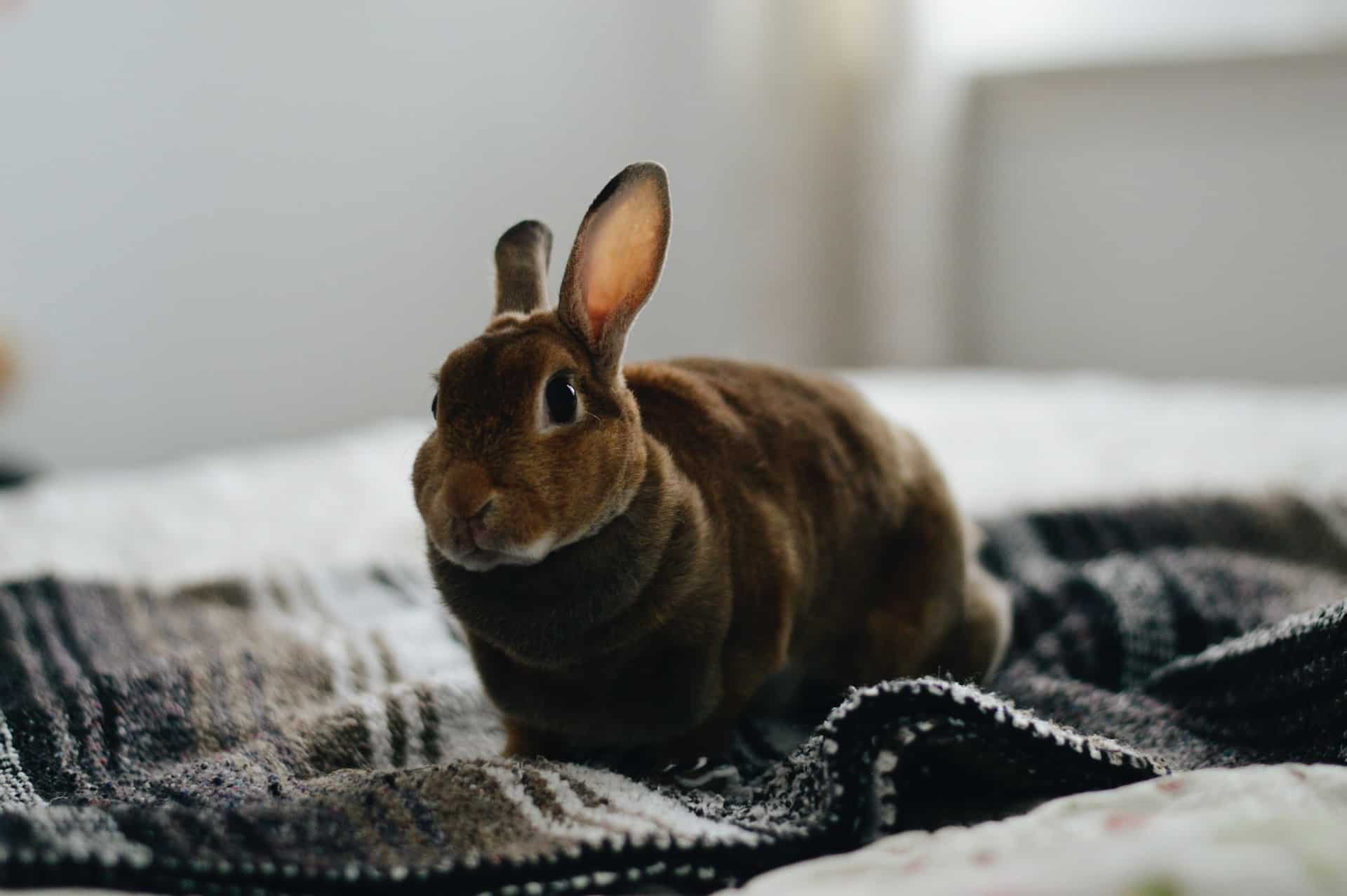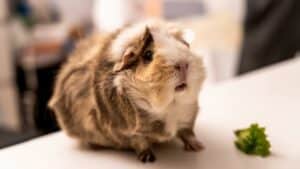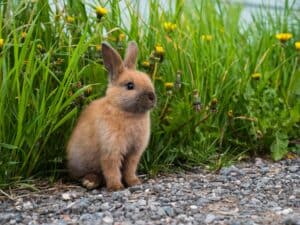| TL;DR: Rabbits are precocious breeders and become sexually mature at 4 – 6 months old. They can breed year-round and produce large litters of kits. The gestation period lasts approximately 30 days. Physical changes are not very pronounced in pregnant rabbits, although they may become more aggressive and display nesting behaviors. Proper care of a pregnant doe involves providing her with a stress-free environment and a nutritious diet. After giving birth, a mother rabbit leaves her nest to avoid attracting predators. She will, however, feed her kits once or twice a day. The kits will remain in the nest for the first few weeks, feeding on the doe’s milk until they are about 10 days old, when they start eating solid food. Handling kits from a young age promotes socialization and helps them become more comfortable with human interaction. |
Rabbits have long been known for their remarkable breeding patterns, giving rise to numerous sayings and myths. However, behind the folklore, there is truth. Female buns can get pregnant very easily. Whether intentional or accidental, this often leads to the arrival of a litter of adorable fluffy bunnies.
So, what happens next? How can you ensure the health and well-being of the pregnant rabbit and her babies?
In this article, we will explore the intricacies of rabbit reproduction, from identifying the signs of pregnancy to providing the necessary care during and after pregnancy.
Additionally, we will delve into the essential care required for newborn kits.
Rabbits Are Pregnant for Approximately One Month
Rabbits are remarkable creatures when it comes to reproduction. They are precocious breeders and reach sexual maturity as early as 4 – 6 months old.
Female rabbits, known as does, are induced ovulators — they ovulate in response to an external stimulus. This is typically after mating, although other factors like stress can also induce it.
So, when a sexually mature doe spends time with a sexually active male rabbit, known as a buck, the most likely result is pregnancy.
Although bunnies generally prefer warmer seasons for breeding, they can reproduce year-round. Furthermore, a doe can become pregnant again only a couple of hours after kindling (giving birth).
A rabbit’s gestation period is relatively short, lasting around 30 days. But what sets them apart is their ability to produce large litters. On average, a single pregnancy can result in five to eight baby rabbits, known as kits. However, litters of 12 are not unheard of.
| ???? World Record: According to the Guinness World Record, the largest recorded rabbit litter consisted of an impressive 24 kits and it happened on two occasions: in 1978 in New Zealand and in 1999 in Canada. |
Signs of Rabbit Pregnancy
Does may not display many physical signs of pregnancy during the first stages of gestation. However, some specific behaviors — and eventually physical changes — reveal when a bunny is expecting.
Here are the three most common tell-tale signs:
1. Mood swings: Aggression and irritability
Pregnancy can induce unexpected shifts in a doe’s temperament. She will probably become more aggressive and quite territorial only a few days after becoming pregnant. Growling and biting are not uncommon during this period. But not to worry, these mood changes are temporary, your bun will return to her usual self after the pregnancy.
2. Nesting Behaviors: Digging and Fur Pulling
If a doe digs intensely in her pen, she mimics wildlife behavior: building nests in underground burrows. She will use and gather hay, straw and other bedding materials to make a welcoming nest for her kits.
Don’t be alarmed if she pulls her own fur to add to the nest. It’s an essential ingredient for a soft, warm bed and carries her reassuring scent for future newborns.
3. Physical changes: Weight Gain and Rounded Abdomen
As the pregnancy progresses, your rabbit’s abdomen will expand. While it may not be immediately noticeable, a pregnant rabbit will gain some weight. The larger the litter, the more pronounced the changes in the abdomen will be.
After around two weeks post-breeding, the unborn kits will appear like marble-sized bumps inside the doe’s belly. You may even feel them moving and turning by gently stroking her abdomen.
| ???? Fun Fact: Does can experience pseudopregnancies and believe they are pregnant when they aren’t. Clinically referred to as pseudocyesis, this condition can be triggered by sexual stimulation from neutered males or even female rabbits. During a pseudopregnancy, which lasts about two to three weeks, the doe will exhibit nesting behaviors and act moody. |
Caring for Your Pregnant Rabbit
The gestation period in rabbits is generally calm and straightforward and mother rabbits are quite self-sufficient. However, there are some things you can do to ensure your bunny experiences a smooth and safe pregnancy.
So, here are a few suggestions to pamper and care for your bun during this time.
Tip 1: Create Appropriate Housing
Make sure the enclosure is spacious enough for her and her litter — remember that a doe can give birth to as many as 14 little ones. The American Rabbit Breeders Association provides a table of minimum cage sizes based on the doe’s size.
Still, as a general guideline, a cage 25-30 inches in length and 15 inches in width should provide sufficient space for the whole bunny family.
Tip 2: Provide Essential Nesting Materials
Help your bunny create a cozy nest for her kits by providing suitable materials such as hay and straw. You can add scraps of paper or cardboard to the mix, but it is better not to include fabric scraps or any similar material with fine threads or holes, as they could be dangerous for the newborn.
Offer her a nesting box as well. Nesting boxes can be made of metal, wood, cardboard, or plastic and should be slightly larger than the mother rabbit. But be careful not to introduce it too early, as your bunny could use it as a litter box. The best time to put it in the enclosure is around days 27 – 28.
| ???? Pro Tip: If possible, opt for easy-to-clean options. For instance, cat plastic litter pans filled with hay and bedding material can work well as nesting boxes. Wooden or cardboard boxes, on the other hand, are not as simple to clean. When cleaning them, it’s best to avoid using disinfectants or chemical cleaners as those materials can absorb toxins harmful to rabbits. |
Tip 3: Create a Stress-free Environment
Place the enclosure in a quiet area, away from loud noises and excessive activity. If your doe is usually housed with a buck, separating them during this period is best to prevent any aggression. However, keeping them close and able to see and smell each other is important. Bonded rabbits could get depressed if they are completely separated.
Additionally, ensure that other household pets are unable to approach her, even if they are familiar, as she may perceive them as a threat to her and her kits’ safety.
Tip 4: Ensure Adequate And Nutritious Diet
Pregnant does require a higher calorie and nutrient intake for the proper development of the kits. Increase the rations, providing more fresh vegetables, water and high-quality rabbit pellets. During this time, alfalfa is a better option than grass hay, as it is richer in calcium and protein and greatly nutritious for the kits gestating inside her.
After Rabbits Give Birth
Kindling typically occurs in the early morning hours. The entire process is quick, lasting between 10 minutes to half an hour. Once the kits are born, the doe will eat the placenta, which provides many vitamins, iron and minerals for a swift post-birth recovery. After tending to the newborns, the doe will leave the nest, and you will know kindling is over.
This behavior is completely natural and stems from rabbits’ wild instincts. At birth, kits are tiny and furless creatures with their eyes and ears shut. Being so defenseless, they are best protected by burrowing in their nest, safe from predators.
For the same reason, their mother won’t stick around. She instinctively knows it’s crucial to avoid attracting unwanted attention to the nest. That is why she will feed the kits only once or twice a day, typically in the morning and evenings.
| ???? Facts About Rabbit Milk Interestingly, rabbit milk is exceptionally nutritious, and kits can consume up to 20% of their body weight in just one feeding, sustaining them for a full 24-hour period. Besides, while the doe may not physically enter the nest during the day, she keeps a watchful eye from a safe distance. While it’s best not to scoop up the newborns for a few days, monitoring their development is important. By observing their tummies, you can assess whether they are getting the necessary nourishment. A plump, round tummy means they’re being well-fed. On the flip side, if their tummies look sunken and their skin appears all wrinkly, it’s a sign they might be dehydrated and hungry. In that case, keep them warm and seek vet advice. |
Raising Infant Rabbits (Kits)
Embarking on the rewarding task of raising baby rabbits involves two key aspects: handling these delicate creatures with care and providing them with the proper nutrition they need as they grow.
Let’s explore these topics in detail.
???? Can I touch the baby rabbits?
When handling baby rabbits, it is safe to pick them up as long as you treat them with utmost care. Handling them after they reach 10 days old can benefit their socialization and make them more tolerant of human interaction.
The mother will not usually reject a kit for smelling like you, especially if you have a strong relationship with her. However, to be safe, it is best to stroke the doe and have her scent in your hands before touching the baby buns.
As the kits reach three weeks old, they become more ready for frequent interaction. You can pet them and allow them to hop onto your lap, but always be gentle and attentive to any signs of stress. Additionally, providing play, exploration and exercise opportunities is crucial for their well-being.
???? What do kits eat?
Proper nutrition plays a vital role in the development of baby rabbits. Their delicate digestive system requires careful attention. Initially, their diet consists of their mother’s milk, which they drink until they are around eight weeks old.
At approximately 10 days old, baby rabbits open their eyes and nibble on solid food. Two essential components of their diet are alfalfa hay, which provides important calories and quality hay pellets for well-rounded nutrition. It’s also normal for kits to start eating their mother’s cecotropes, a specific type of feces that helps develop healthy gut bacteria.
Upon their eighth week, they are ready to be introduced to vegetables or leafy greens. However, as their digestive system is still adjusting to solid food, it is important to do so gradually, one type at a time. This will avoid stomach problems and potential diarrhea.
During this whole process and until they are completely weaned, it is best to keep the kits with their mother. Once they become more independent, they will be ready to embark on their own rabbit adventures.
Final Thoughts
Although rabbits may not display conventional parental behaviors, they have their special way of caring for their younglings. It’s important to know what to expect and be prepared to provide the necessary care and affection to ensure your bunny’s and her kits’ well-being.
Having a trusted veterinarian on hand is always a wise choice. Their guidance will help you navigate each step of the journey with confidence.
As you witness the kits’ growth and development, prepare for countless joyful and heartwarming moments. You’ll be captivated as they explore, play and hop around with boundless energy.
| SOURCES American Rabbit Breeders Association (2019). ARBA Recommendations for the Care of Rabbits and Cavies. Arba.net Carter, C. L., et al. (2016). An Incidence of Pseudopregnancy Associated with the Social Enrichment of Rabbits (Oryctolagus cuniculi) ncbi.nlm.nih.gov Cosgrove, N. (2023). How Long Are Rabbits Pregnant? Petkeen.com First Vet (2022). Rabbit Pregnancy, Birth, and Baby Care. firstvet.com Harcourt-Brown, F. (2002). The Rabbit Consultation and Clinical Techniques. Ncbi.nlm.nih.gov Harriman, M. (2022). Food and Diet. rabbit.org Mayer, J. (2022). Management Of Rabbits. merckvetmanual.com Van Praag, E. (2023). Disorders of the urinary and reproductive systems. medirabbit.com |





